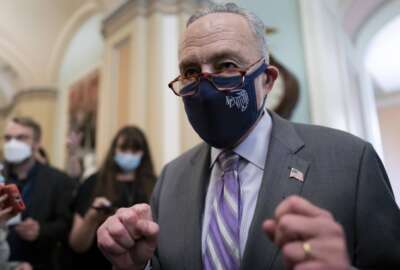Criminal money mules are finding themselves tethered to the hitchin’ post
The Justice Department's Money Mule initiative has been running for four years, and it's gaining ground. For what it is and how it works, the consumer protectio...
Best listening experience is on Chrome, Firefox or Safari. Subscribe to Federal Drive’s daily audio interviews on Apple Podcasts or PodcastOne.
Financial criminals need mules to move the cash. The Justice Department builds fences to keep the mules from getting very far. In fact, the Money Mule initiative has been running for four years, and it’s gaining ground. For what it is and how it works, the consumer protection branch deputy assistant attorney general Arun Rao joined Federal Drive with Tom Temin.
Interview transcript:
Tom Temin: Mr. Rao, good to have you on.
Arun Rao: Thank you, Tom. I’m glad to be here.
Tom Temin: And this mule initiative, we love the name of that program, and it has been going now as according to what the Justice Department is saying, for a few years now. What is it? Sounds like an attempt to stop money laundering by stopping the people that carry cash around.
Arun Rao: Yes, that’s right. It’s an annual law enforcement effort. And it focuses on disrupting what we call money mule networks. These are networks that enable foreign fraud schemes. And as you pointed out, it’s been happening for a number of years now, this is the fourth year that US law enforcement agencies have engaged in this effort. It also runs concurrently with a campaign handled by Europol the European Money Mule Action, and it’s designed to target the facilitation of the movement of billions of dollars of money, which, in essence, represents losses in a wide variety of fraud schemes.
Tom Temin: And what is the general origination source of the cash that people carry around? I assume it’s currency that they carry around.
Arun Rao: It’s frequently currency. We had a recent example of a case in, I believe it was in California, in which the defendants actually went door to door and obtain cash from the victims. This was in a so called grandparent scam. So the fraudsters would call the victims, they would claim that a loved one was in trouble and needed immediate assistance for bail. And then we’d show up in the door and believe these individuals frequently have cash go with them sometimes to the bank and take cash out. Other times, it’s money transfers. And so the use of bank accounts.
Tom Temin: Got it. Does it also, though, cover money laundering for other types of organized crime?
Arun Rao: Yes, frequently, the charges when they’re ultimately brought, they can include money laundering, they can include wire fraud, they can include other kinds of fraud charges.
Tom Temin: And because other agencies are involved, well, let me ask you this, because crimes happen in various domains, say maybe involving postal fraud, does justice work with other agencies? Is this a multi-agency effort, the mule campaign?
Arun Rao: It is. So it’s coordinated by the Department of Justice’s Consumer Protection Branch,. We work closely with the FBI and the US Postal Inspection Service. But we also work with a number of different agencies, including the Department of Labor’s Office of Inspector General, Homeland Security Investigations, the Small Business Administration’s Office of Inspector General, and the Secret Service. And in particular, we here at the Consumer Protection Branch work with the United States Attorney’s offices around the country.
Tom Temin: And what is the extent of money muling that happens? Do we have any idea of how extensive the whole thing is?
Arun Rao: That’s an excellent question. Those answers are difficult because fraud typically is under reported. And particularly with some of these schemes, victims sometimes feel shame, they’re afraid to tell their loved ones or law enforcement that they’ve been victimized. And so getting exact numbers is a little bit difficult, Tom, but what we can tell you is that it’s a serious problem. It’s a common tactic, again, across a wide range of fraud schemes, regardless of the particular form they take, ultimately, they require the movement of money. That’s why the fraudsters are doing what they do. And so while we don’t know exactly how much money has moved through money mules, a conservative estimate places that in the billions. And again, this is a nationwide problem. During the course of the 10 weeks of the money mule initiative, this year we took actions in every state in the United States,
Tom Temin: Really. And by the way, what is the form of a money mule? Is it someone carrying a briefcase full of $20 bills or what does it look like?
Arun Rao: That’s a great question. It can be someone who simply carrying cash. It can also be someone who’s instructed to open bank accounts. And so one of the things we encourage folks listening to this program, and people who’ve been become aware of the money mule initiative, to take away from this is that people can protect themselves by learning how they might be recruited by these types of fraudsters. People shouldn’t agree to accept money or packages from people they don’t know. They shouldn’t agree to open bank accounts at someone else’s direction. That’s frequently a method that’s used here. And also use care when responding to online job postings that make promise easy money in exchange for very little work, particularly when that work involves sending and receiving packages.
Tom Temin: We’re speaking with a Aron Rao, he is the Consumer Protection Branch Deputy Assistant Attorney General at the Justice Department. And how does the case get initiated? How do you know, say, to say let’s go look for these people or this guy or this woman, because we think they might be a money mule that lead us to other criminals? How do you get started?
Arun Rao: Another great question, Tom. I can’t get into a lot of specifics on this question, but I think tell you, generally speaking, we obtain information from a wide range of sources that can include information from reports victims file with law enforcement. And so again, I want to encourage those who think they may have been a victim of such a scheme to make the reports to their local law enforcement or to the FBI. Another example is information that comes to us from financial institutions when they encounter suspicious activity. So a great deal of traffic out of a bank account, multiple bank accounts, opening and closing, odd numbers of transfers to overseas accounts. Those are the kinds of things that can bring these cases to the attention of law enforcement.
Tom Temin: Yes. And when you find someone that is a mule, do you find that the mule is also the original perpetrator of the fraud? Or do the perpetrator sometimes unload the physical motion of the cash to other people for a commission, I guess?
Arun Rao: The answer is it depends. Sometimes the people involved in the transfer of funds are the fraudsters themselves. But other times they’re what we call potentially unwitting. And in those cases, we adopt a very different approach than simply pursuing a criminal prosecution. Criminal charges and civil lawsuits are warranted for witting and complicit money mules. But what we hope to do and a lot of cases where we’re dealing with an unwitting individual is to warn them, make them aware of the impact of their actions, and then hopefully prevent and disrupt the activity that way. So what we found, Tom, is that these letters can be incredibly effective. Most individuals who we contact via these warning letters that we send out, appear to stop moving money fraud. And fraudsters put a tremendous amount of time and effort into cultivating each of these money mule contacts. And so with a relatively limited expenditure of law enforcement resources, a telephone phone call, a meeting in person, we can significantly impede foreign fraud operations by raising the costs of these activities.
Tom Temin: Okay, and let me ask you this, this is a 10 week effort every year, how come it’s not year round?
Arun Rao: It is a year round activity. It is a 10 week initiative that focuses on both action components and outreach components. So this is an effort to publicize activities that are going on 365 days a year. But during the 10 week campaign, we also conduct a significant amount of outreach activity. As I just described to you sort of a moment ago, we have elder Justice coordinators across the country who focus on educational activities to tell folks in the community about money mule activity. The US Postal Inspection Service created flyers that were displayed in post offices across the country. And then the FBI Internet Crime Complaint Center released a money mule public service announcement during that time as well. And so that’s what makes the campaign different. The law enforcement activity, your right to note goes 365 days a year, but during this 10 week, we try to highlight some of the activities that have been occurring across the year. And also, again, focus on significant outreach to the community.
Tom Temin: And if you have a mule, and there is money on that person, is it seized or what happens?
Arun Rao: Yes, it can be seized, and then ultimately, it can be forfeited to the government. But most importantly, what we’re trying to do is return these funds to the victims. Once these funds leave the country, it becomes very difficult for us to bring them back in to make the victims whole. And so we are again focused on making victims whole because in a lot of these fraud scams, Tom, people end up losing their life savings, and it can have a significant financial impact. And so what we want to do here is to try to obviously first prevent the crime street but occurring in the first place. But then also when they have occurred, seize those funds where we can and return it to the individuals.
Tom Temin: Sounds like you might nab a lot of people at the airports. It sounds like there’s an international flavor to the whole system here.
Arun Rao: That’s absolutely right. And again, this effort runs concurrently with a campaign in Europe called the European Money Mule Action. And so it requires a great deal of coordination particularly once the funds have gone across United States border.
Tom Temin: Arun Rao is Consumer Protection Branch Deputy Assistant Attorney General. Thanks so much for joining me.
Arun Rao: Thank you, Tom. It was a pleasure.
Copyright © 2024 Federal News Network. All rights reserved. This website is not intended for users located within the European Economic Area.
Tom Temin is host of the Federal Drive and has been providing insight on federal technology and management issues for more than 30 years.
Follow @tteminWFED






